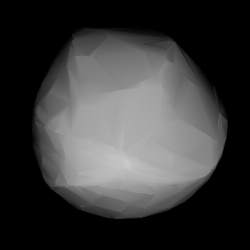Astronomy:247 Eukrate
 3D model based on lightcurve data | |
| Discovery | |
|---|---|
| Discovered by | Robert Luther |
| Discovery date | 14 March 1885 |
| Designations | |
| (247) Eukrate | |
| Pronunciation | /juːˈkreɪtiː/[1] |
| Named after | Eucrate |
| A885 EB, 1901 TB 1947 TA, 1960 TC | |
| Minor planet category | Main belt |
| Orbital characteristics[2] | |
| Epoch 31 July 2016 (JD 2457600.5) | |
| Uncertainty parameter 0 | |
| Observation arc | 131.09 yr (47880 d) |
| |{{{apsis}}}|helion}} | 3.4086 astronomical unit|AU (509.92 Gm) |
| |{{{apsis}}}|helion}} | 2.0778 AU (310.83 Gm) |
| 2.7432 AU (410.38 Gm) | |
| Eccentricity | 0.24257 |
| Orbital period | 4.54 yr (1659.5 d) |
| Average Orbital speed | 18.0 km/s |
| Mean anomaly | 75.9892° |
| Mean motion | 0° 13m 0.948s / day |
| Inclination | 24.991° |
| Longitude of ascending node | 0.16410° |
| 54.969° | |
| Physical characteristics | |
| Dimensions | 134.43±2.5 km |
| Rotation period | 12.093 h (0.5039 d) |
| Geometric albedo | 0.0595±0.002 |
| CP | |
| Absolute magnitude (H) | 8.04 |
Eukrate (minor planet designation: 247 Eukrate) is a rather large main-belt asteroid. It is dark and probably a primitive carbonaceous body. The asteroid was discovered by Robert Luther on March 14, 1885, in Düsseldorf. It was named after Eucrate, a Nereid in Greek mythology.
In 2001, the asteroid was detected by radar from the Arecibo Observatory at a distance of 1.18 AU. The resulting data yielded an effective diameter of 134 ± 15 km.[3]

There have been 9 occultation observations of this asteroid since 2004.[4] The latest of 2018 May 12 was a 5 chord observation that allows, using Occult (Software), the scaling of the DAMIT model 1207, to yield a Mean volume-equivalent diameter of 137.5 km and a Mean surface-equivalent diameter of 140.0 km.
References
- ↑ A rare case of a long alpha in Greek, eukrātē,[1] so the stress is on the 'a'. Cf. eucratic (3rd ed.), Oxford University Press, September 2005, http://oed.com/search?searchType=dictionary&q=eucratic (Subscription or UK public library membership required.)
- ↑ "247 Eukrate". JPL Small-Body Database. NASA/Jet Propulsion Laboratory. https://ssd.jpl.nasa.gov/sbdb.cgi?sstr=247;cad=1.
- ↑ Magri, Christopher et al. (January 2007), "A radar survey of main-belt asteroids: Arecibo observations of 55 objects during 1999 2003", Icarus 186 (1): 126–151, doi:10.1016/j.icarus.2006.08.018, Bibcode: 2007Icar..186..126M, http://echo.jpl.nasa.gov/asteroids/MBAs/magri.etal.2007.mbas.pdf, retrieved 2015-04-14.
- ↑ "PDS Asteroid/Dust Subnode" (in en). https://sbn.psi.edu/pds-staging/resource/occ.html.
External links
- The Asteroid Orbital Elements Database
- Minor Planet Discovery Circumstances
- Asteroid Lightcurve Data File
- 247 Eukrate at AstDyS-2, Asteroids—Dynamic Site
- 247 Eukrate at the JPL Small-Body Database
 |

